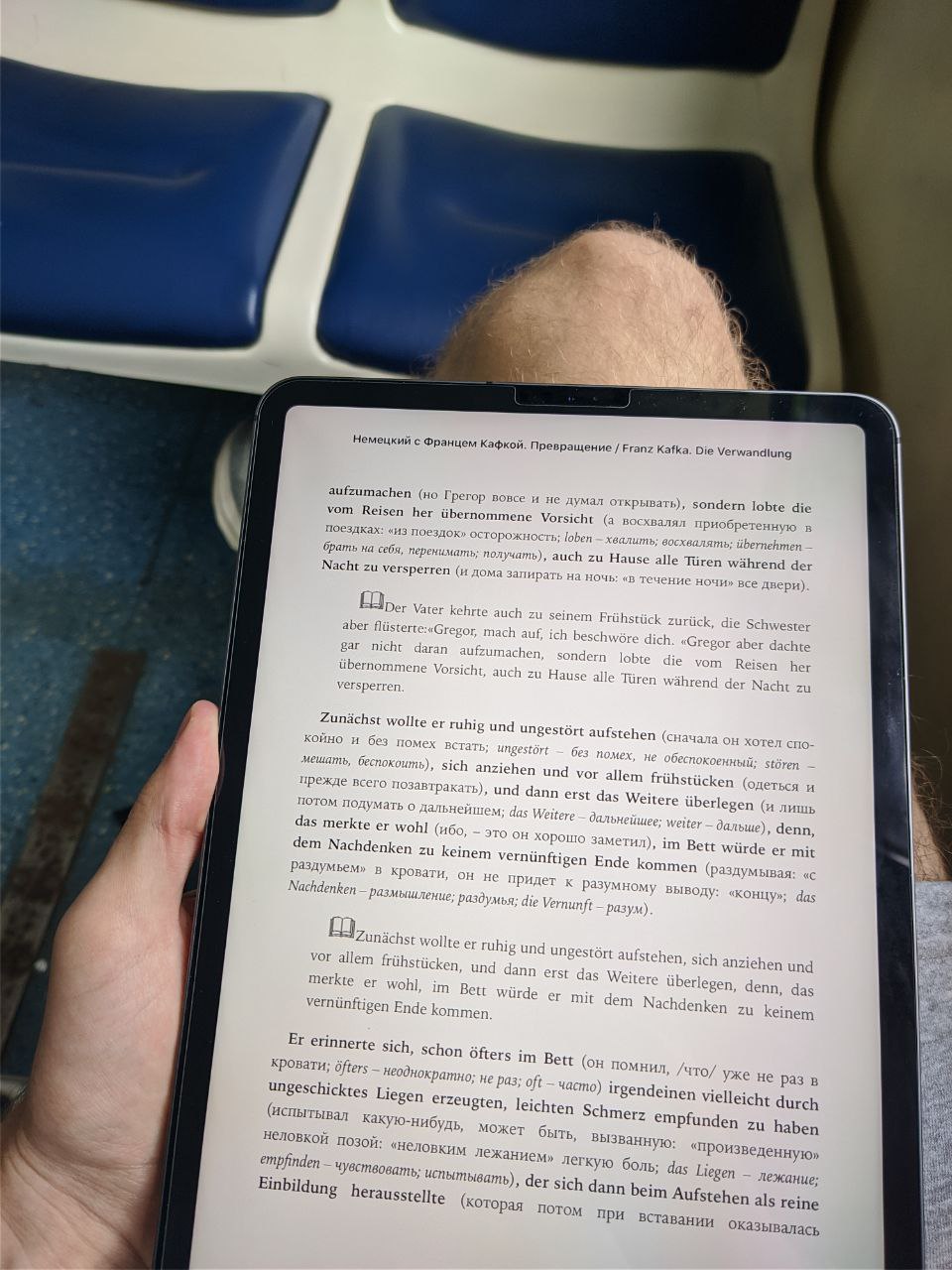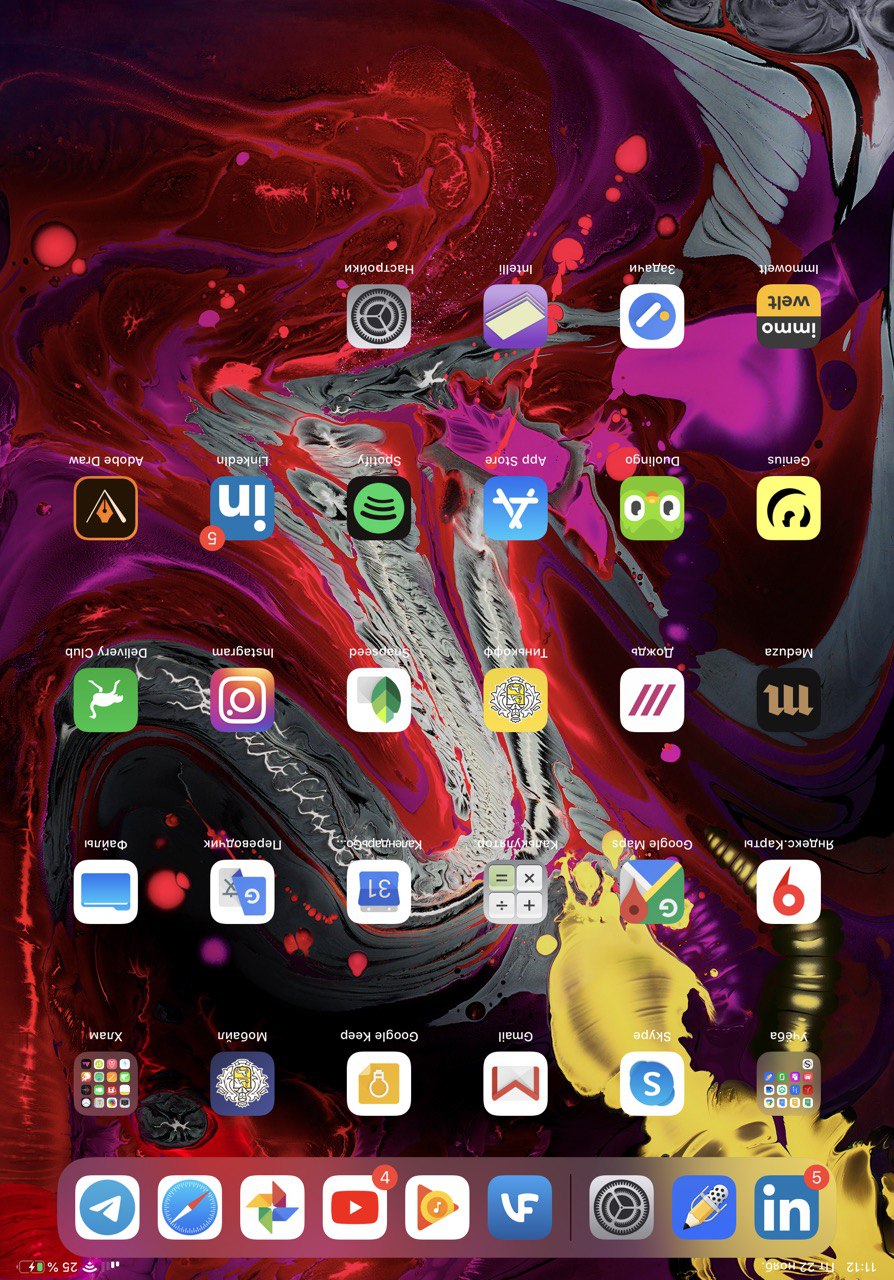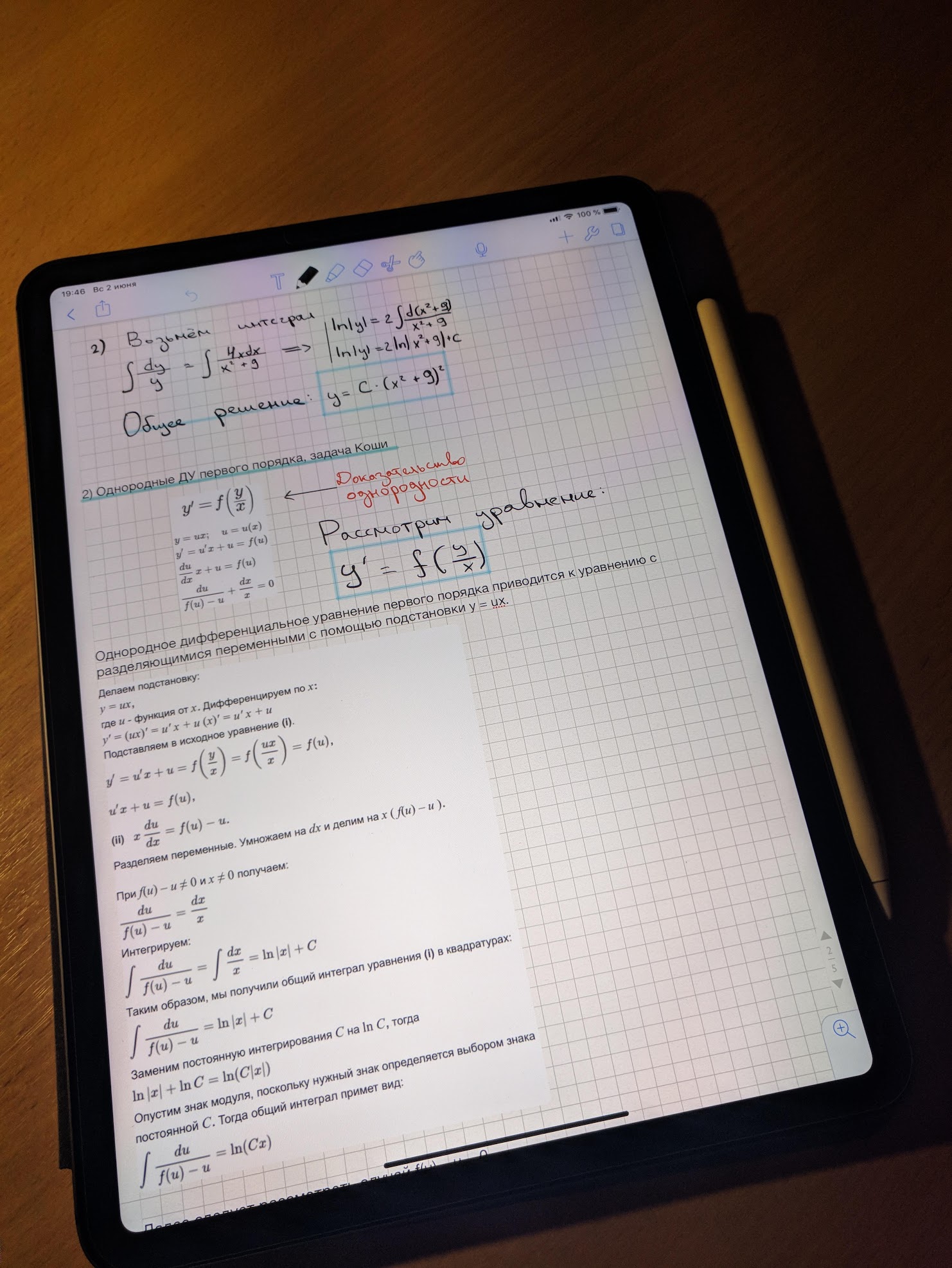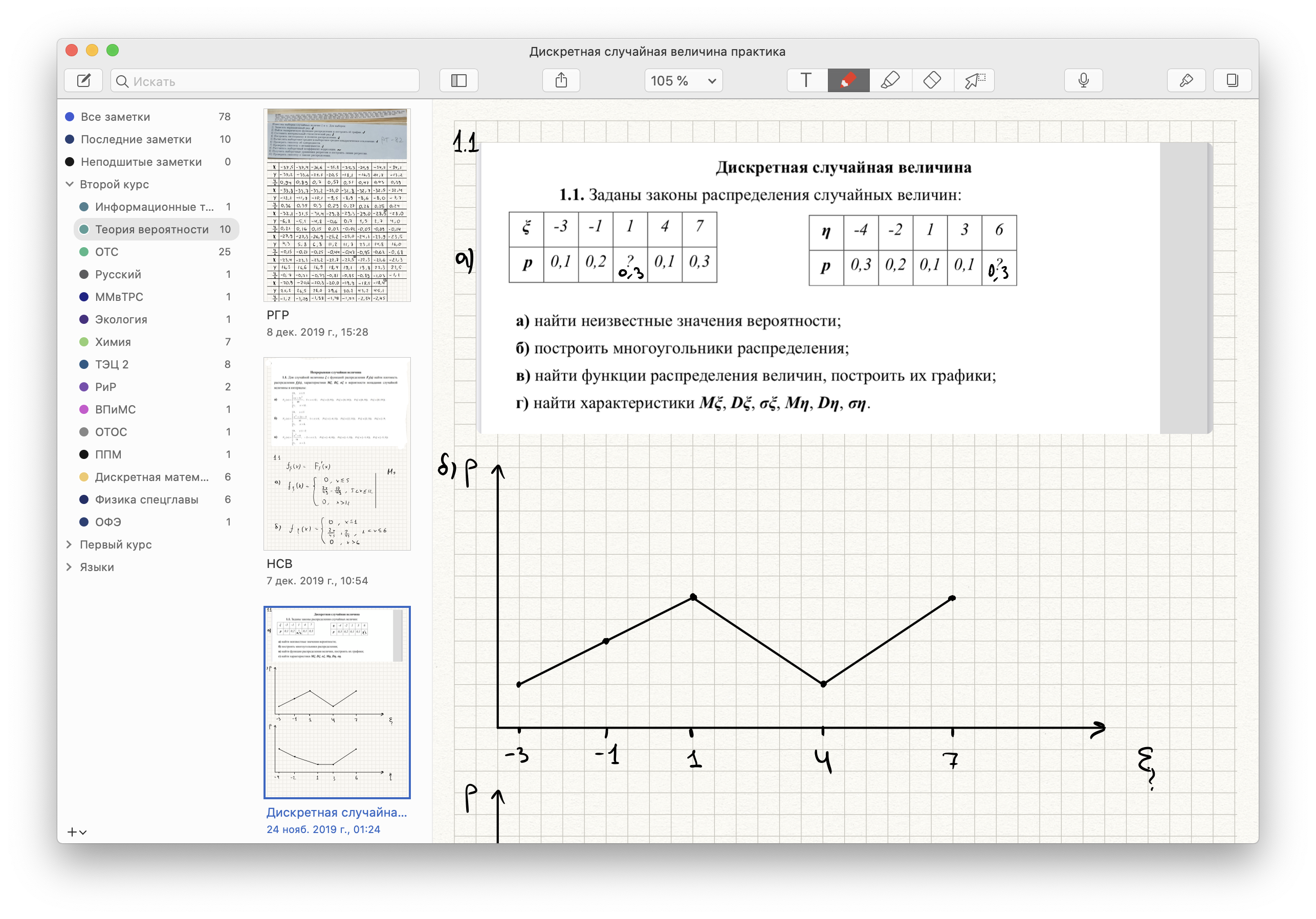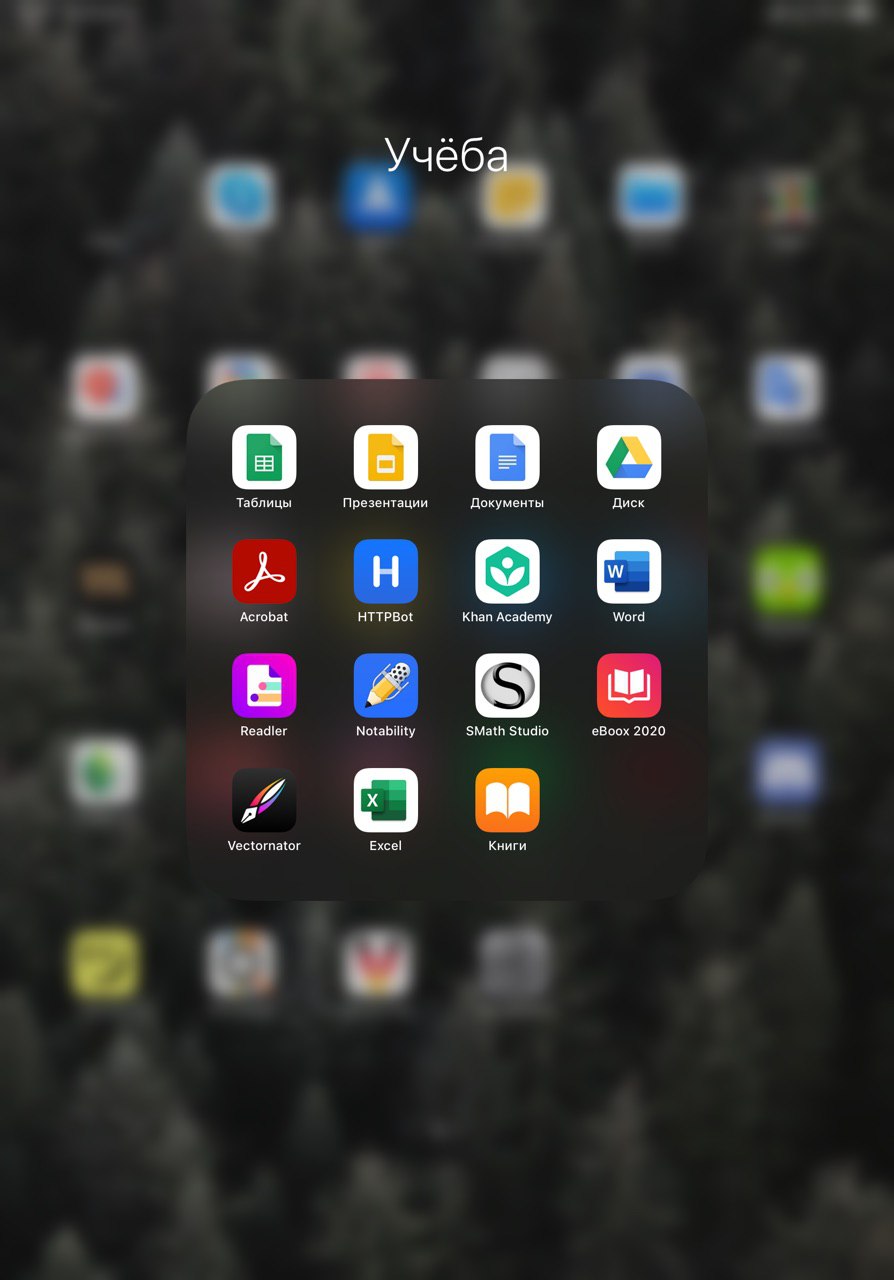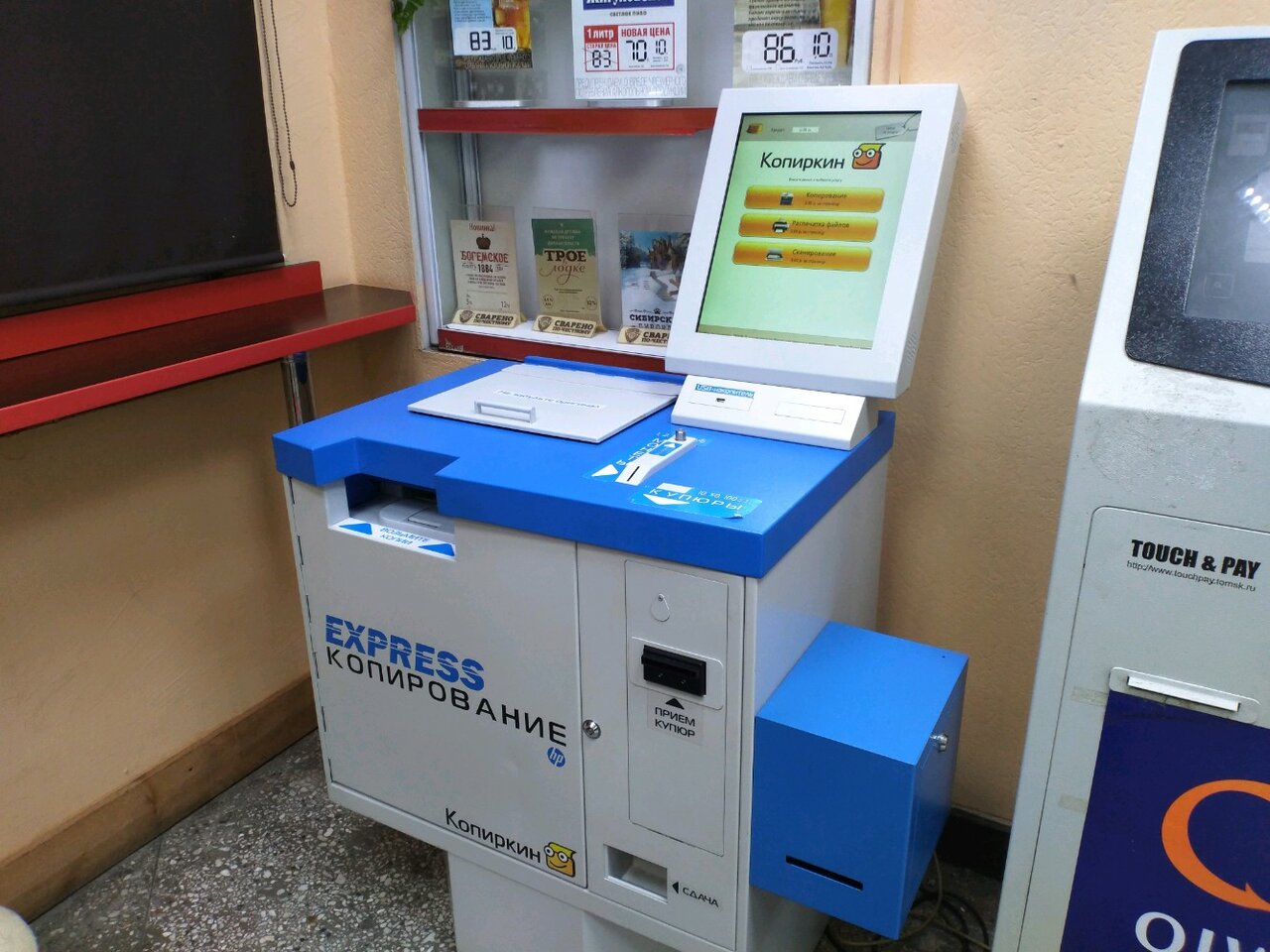Что лучше goodnotes или notability
iPad Pro вместо конспекта — проходил с ним год, делюсь радостями и проблемами
Как прогрессивного студента технического вуза, меня в нашем ещё развивающемся мире смущает всего три вещи:
В попытке побороть хотя бы третью проблему, в начале 2019 года я приобрёл iPad Pro 2018 и Apple Pencil 2-го поколения. Преимущества казались очевидными:
Всё оказалось не так однозначно, так что спешу поделиться опытом с потенциальными пользователями.
Первые впечатления от замены тетрадей на планшет
Тонкий и мощный планшет действительно вызывает желание лишний раз взять его в руки. В отличие от того же 13-дюймового макбука он даже не ощущается в рюкзаке, иногда приходится проверять не забыл ли я его взять. У меня модель на 11 дюймов с LTE и 64 ГБ памяти — оказалось этого более чем достаточно если не играешь, у меня свободно 27 ГБ. Гипотетически я мог бы взять и модель попроще, но в новых Pro’шках подкупил Type-C и возможность заряжать стилус без костылей, простым примагничиванием к боковой грани.
iPadOS в большинстве случаев не подводит, наверное пару лет назад мне бы не хватало возможности читать флешки или скачивать файлы в браузере, но сейчас в этом плане отставания от полноценных систем нет. Стабильность средненькая, периодически возникают проблемы с автоповоротом — например, интерфейс переворачивается, а док остаётся сбоку. Бывает что устройство перезагружается если пытаешься открыть файл в программе, не поддерживающей его, например если попался редкий книжный формат. Учитывая отличный процессор и экран 120 Гц забавно наблюдать как разработчики то и дело что-то ломают, планшет демонстрирует все баги с высочайшей частотой кадров.
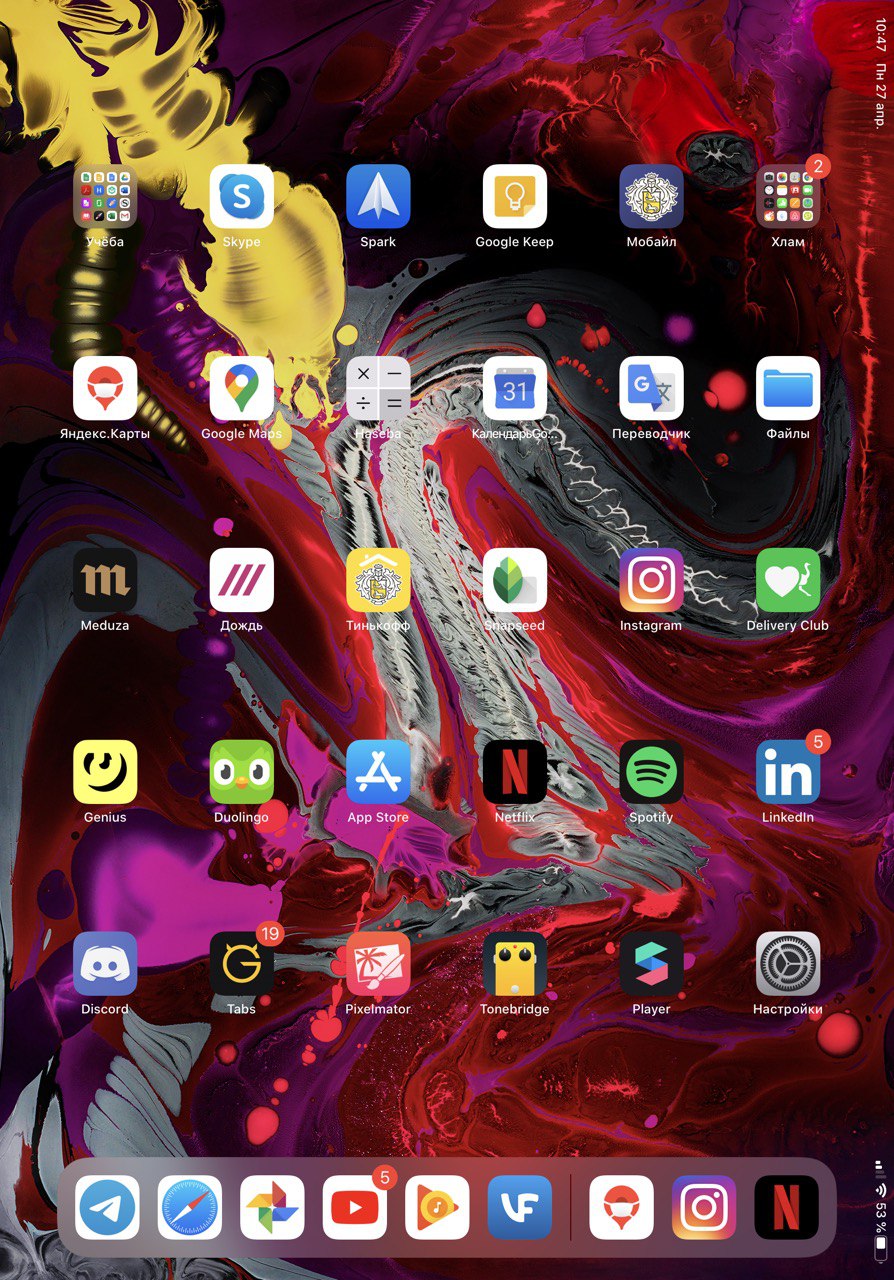
Отдельной похвалы заслуживает батарея, при статичной картинке и яркости 40% можно даже после 4-5 часов работы вернуться домой с 50-60% заряда — спасибо технологии ProMotion.
Аксессуары, без которых не обойтись
У меня была возможность попробовать родную клавиатуру, но мне такая прибавка к весу показалась необоснованной, справляюсь и с экранной. Жаль, что в Apple никто не додумался точку и запятую на огромном экране сделать отдельными клавишами, а если пользоваться сторонними клавиатурами, то очень быстро надоедает переключать их по кругу после каждого ввода пароля.
Pencil на моей памяти никогда не разряжался, если у вас есть такие опасения. Заряжается примерно за час, разряжается за 2-3 часа работы. Жесты на сенсорной панели — очень крутая штука, переключаюсь между карандашом и ластиком мгновенно. Единственное — в перерывах между абзацами можно отвлечься и случайно переключиться на ластик, потом секунду пытаясь понять, почему же ничего не рисуется.
Крайне важный софт и его удобство
Моё главное приложение для ведения конспектов — Notability. Есть ещё GoodNotes с похожим функционалом, но его интерфейс мне не понравился. В Notability всё легко сортируется и кастомизируется. Есть папки, в них категории (предметы), а в категориях уже заметки — где-то удобнее каждое занятие выносить в отдельную заметку по темам, где-то писать всё в один связанный текст — он хорошо индексируется и ищется через поиск. Линии и геометрические фигуры сами выпрямляются, так что при наличии времени и желания ваш конспект даже будет красивым, но у меня примерно такой:
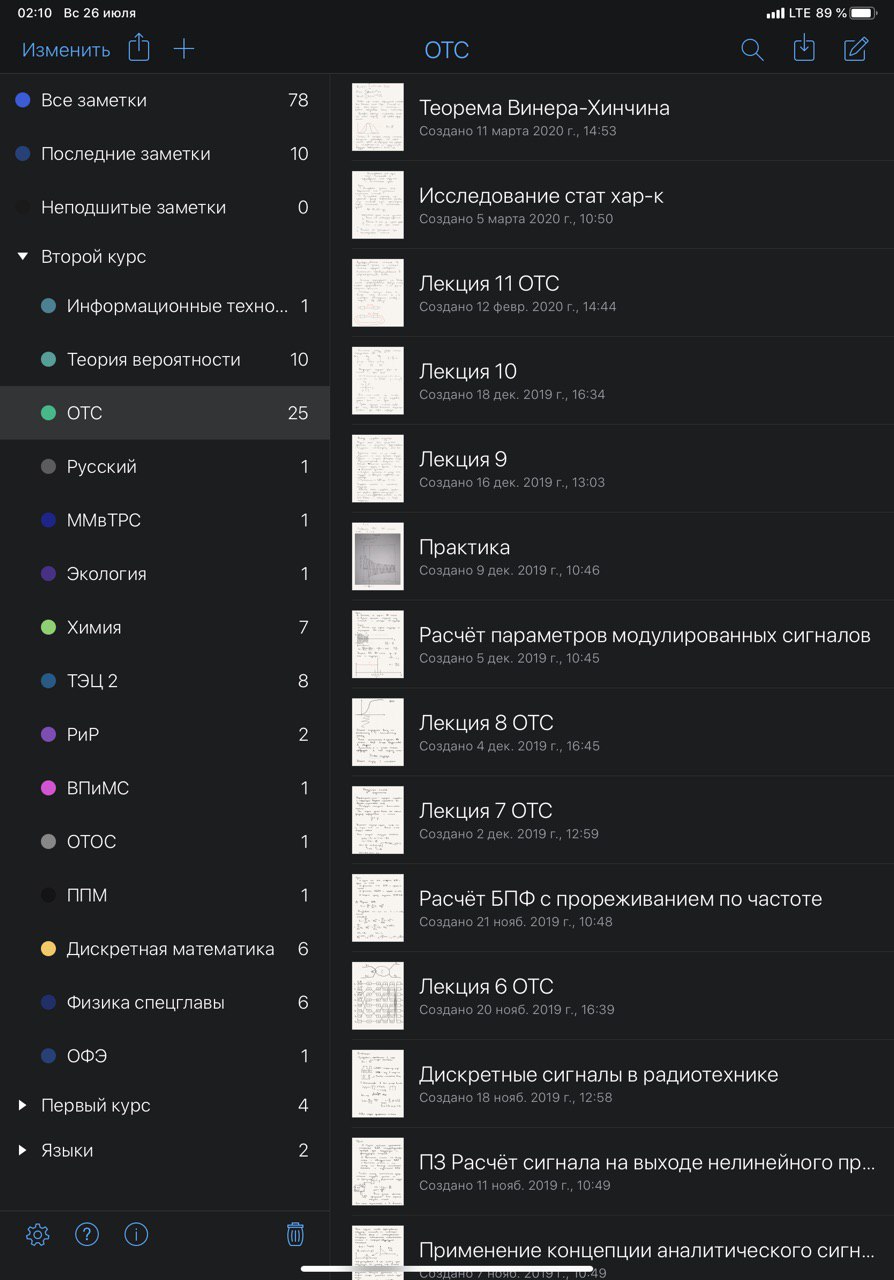
Очень удобно вместо перечерчивания графиков из презентации на экране просто сфоткать их, а в своих работах вставлять графики и таблицы прямо из Excel. Правда текст на фотографиях не индексируется, по крайней мере на русском языке.
Синхронизация с версией для Мака работает отлично, единственное что покупать их приходится по отдельности — по 700₽, но это точно лучше, чем подписка. Можно включить автозагрузку конспектов в Google Диск и поделиться нужными папками, я так скидывал записи одногруппникам.
Офисный пакет — в первую очередь от Google, так как Word или Excel не дают редактировать документы без своей подписки, их имеет смысл держать разве что для более корректного отображения. Для PDF и прочих популярных форматов подходит встроенное приложение «Книги». Его минус только в том, что оно не даёт листать документ во время редактирования стилусом, так что иногда может пригодиться Acrobat. Если всё же придётся где-то столкнуться с бумагой, то её легко отсканировать через «Заметки».
Некоторого особенно специфического софта не хватает, для гуманитарных сфер проблем возникнуть не должно, но если нужен MathCAD или LabView — приходится довольствоваться аналогами с урезанным функционалом. Вместо маткада на iPad’е есть SMath, в нём есть основные функции и построение графиков на крайний случай, но скорее всего придётся просить помощи у товарищей с Windows.
Здорово и то, что в скучные моменты лекций можно под шумок переключиться на Duolingo или книгу, а держа карандаш в руке никто и не догадается что именно ты там читаешь или пишешь. Многозадачность в этом плане ещё не подводила.
Проблемы, от которых никуда не деться
Ключевая проблема в том, что какие-то работы, которые нужно очень быстро написать и тут же сдать (например лабораторные), нужно в любом случае писать на бумаге. Удобно, что в случае чего их можно отсканировать и хранить копию на всякий случай, но перед каждой работой приходится спрашивать будем ли мы её сдавать. Так что помимо планшета у меня в рюкзаке ещё пара листов и ручка.
Если работу нужно сдать в бумажном виде, но не сразу, то нет никаких проблем распечатать её, даже если забыл об этом дома. У меня всегда с собой флешка, у которой с одной стороны USB C, а с другой USB A, а в университете есть общедоступные принтеры. Никаких претензий по этому поводу за год я не слышал, некоторые преподаватели наоборот удивлялись качеству графиков из-за автовыпрямления линий. Хотя конечно было бы здорово, если бы все работы можно было высылать на почту вместо печати.
Бóльшая проблема — иногда на экзамены разрешают брать конспект и пользоваться им. В таком случае нужно либо печатать весь конспект, либо упускать такую возможность.
Вывод: стоило ли оно того
Я однозначно стал вести больше записей и стал ценить их больше, ведь шанс потери минимален. Не сказал бы, что планшет может стать стимулом к интенсивному обучению, но думаю без него бы я уже окончательно потерял во всём интерес.
Если всё-таки решились на покупку, то советую самый простой iPad 2019 с LTE — модель в два-три раза дешевле, но функционально мало чем уступает, вряд ли вы заметите существенные отличия, да и аксессуары дешевле. А вот на правильном софте не стоит экономить, эти несущественные траты сберегут ваше время, а друзьям можно будет смело похвастаться, что вы вложились в своё образование, а не купили очередную безделушку — звучит ведь убедительно?
Notability Vs GoodNotes
Why Notability
Why GoodNotes
Price
Creating Digital Notes
Notability creates new notebooks in a single tap. GoodNotes has a similar QuickNote option. You can also take more time to create new notebooks in GoodNotes, customising your cover and page templates.
Notability Has Terrible Page Customisation
Notability supports one paper size: A4. It supports only four paper templates: plain, squared, lined and dotted, each with four line-spacing options (where applicable). All your paper templates in Notability are in portrait mode and you can’t rotate them. Notability supports a lot of paper colours though (15), but unfortunately, all the pages in one notebook use the same template down to the colour. You can’t have different page templates in one notebook in Notability.
Notability has the worst paper templates options we have seen in any note-taking app. They’ve ignored this for years and we are curious to see how much longer they’ll keep getting away with it. You can’t even select multiple pages for editing in Notability. Second only to handwriting experience, paper templates are the most important feature in a note-taking app. If they can’t give us the paper templates we need, they should at least let us add custom paper templates to the app’s library. No, that my fellow humans, they have made almost impossible. Adding custom paper templates in Notability is extremely difficult.
GoodNotes Is Better With Page Customisation
GoodNotes has great paper templates options. It supports many page sizes (A7-A3, GoodNotes Standard, Letter and Tabloid) and plenty of paper templates, twenty-two in total! Your pages can either be in portrait or landscape mode. In case you change your mind about their orientation a bit later, you can select multiple pages to rotate or edit them (copy or move them around). GoodNotes supports fewer colours for your paper templates though (yellow, white and dark). That doesn’t even matter because you can save custom page templates to the app’s template library. Talk about convenience! You can also have different paper templates in one notebook; different colours, sizes, grid lines or colours.
| Page customisation | Notability | GoodNotes |
| Page sizes | A4 only | A7 (iPhone)-A3 Letter Tabloid GoodNotes Standard |
| Page orientation | Portrait only | Portrait & landscape |
| Page colours | 15 | White, dark & yellow |
| Number of paper templates | 4 | 22 |
| Adding custom paper templates to the app’s library | – | ✔ |
| Select multiple pages | – | ✔ |
| Different page templates in one notebook | – | ✔ |
| Page rotation | – | ✔ |
Page Customisation: Notability vs GoodNotes
Pen Tool
Notability and GoodNotes are primarily handwritten note-taking apps. In these apps, you mostly hand-write your notes with an active stylus. Notability has four pen tools (ballpoint, fountain, dashed and dotted pens). It has twelve fixed pen sizes, 32 default colours and the ability to add 32 more custom colours to your colour palette. You also get a favourites toolbar in Notability for saving your most used pens, highlighters and erasers. It’s mobile, so you can put on any side of the screen to keep it out of the way.
GoodNotes has three pen tools: ballpoint, fountain and brush pens. It has a millimetre-pen sized system. You can choose the exact thickness you want for your pen, between 0.1-2mm. On your toolbar, however, you can only save three pen sizes and colours at a time. Notability and GoodNotes have different approaches to their pen tools but they both function.
In 2021, GoodNotes has improved its handwriting experience so much that it is better than the one in Notability. GoodNotes has added the ability to adjust pressure sensitivity for its fountain and brush pens, which makes the handwriting experience more pleasant in GoodNotes than in Notability. In GoodNotes you can also adjust the pen tip for your fountain pen, which improves how your handwriting looks in the app. The handwriting experience in Notability is also great and feels like you’re writing on paper.
| Pen Tool | Notability | GoodNotes |
| Pen types | Ballpoint, fountain, dashed & dotted | Ballpoint, fountain, brush |
| Pen size | 12 fixed options | 0.1-2mm variable, save three at a time |
| Pen tip sharpness | – | ✔ |
| Pressure sensitivity | – | ✔ |
| Colours | 32 defaults, add custom | 3 saved on toolbar, add custom |
| Favourites toolbar | ✔ | – |
Pen Tool: Notability vs GoodNotes
Zoom Tool
The zoom tool in Notability is very basic. It has your writing tools on the left side of its toolbar and navigation tools on the right side. You can avoid using auto-advance by minimising this blue section and not writing on it.
Auto-advance in GoodNotes is better than the one in Notability, once you understand how it works. In GoodNotes, the toolbar doesn’t have writing tools on it, but has margin tools instead. Then navigation tools on the right.
| Zoom Tool | Notability | GoodNotes |
| Pen tools on toolbar | ✔ | – |
| Auto-advance | ✔ | ✔ |
| Margin tool | – | ✔ |
| Navigation tools | ✔ | ✔ |
Zoom Tool: Notability vs GoodNotes
Text Tool
In Notability, you can type directly on the page or use text boxes. In GoodNotes, while typing, a text box appears around your text. It disappears when you stop writing. GoodNotes uses the text box approach only. We do not recommend adding text directly on the page in Notability when mixing your handwriting with text.
Since both apps have text box options, we’ll look at that first. In Notability, you can use your Apple Pencil to draw a text box when your text tool is selected. You can also add it from the plus icon on the toolbar. In GoodNotes, you just start typing.
In Notability, your text box can be made from Papers or Colours. In GoodNotes, you can do more with your text boxes:
Notability doesn’t have borders for your text boxes, which makes the feature feel a bit incomplete. Borders are necessary to create boxes and if you want them in Notability, you’ll probably have to draw them in. Both apps let you rotate your text boxes. It’s more cumbersome in GoodNotes because you have to rely on the lasso tool.
In Notability, you can save three favourite text formats. These preset your font, its style (bold, italic or underline), size and colour. For example, you can save presets for headings, paragraphs and emphasis. When typing notes during a meeting or lecture, you don’t have time to customise your text. Tapping on a favourite changes your text format immediately. GoodNotes only offers you three saved colour templates and one text box style, which is clearly not enough. In Notability you can create:
The interactive list tool in Notability is one of the best on the market. Notability checks off, dims and strikes out your completed tasks, making them easier to differentiate from incomplete tasks. Notability has an indentation tool to help with your lists, while GoodNotes does not. Both apps can align your text, but text alignment works better in GoodNotes than in Notability. GoodNotes has also added the ability to adjust line spacing for your text under your text alignment tool.
You can access the notes in your currently opened folder from within Notability’s workspace when using the text tool. This has nothing to do with the text tool, but it’s a useful feature to have. You can even customise the tools on your keyboard toolbar.
Notability has the superior text tool. Even after putting so much effort on the text tool, GoodNotes still lags behind on this feature, but they are headed in the right direction.
| Text Tool | Notability | GoodNotes |
| Text input options | Keyboard, Scribble | Keyboard, Scribble |
| Text box customisation | ★★★ | ★★★★★ |
| Text box rotation | ✔ | ✔ |
| Support for custom fonts | ✔ | ✔ |
| Save favourite text formats | ✔ | – |
| Interactive lists | ✔ | – |
| Lists (numbered & unnumbered) | ✔ | – |
| Indentation tool | ✔ | – |
| Text alignment | ★★★ | ★★★★★ |
| Line Spacing | – | ✔ |
| Customise the tools on the keyboard toolbar | ✔ | – |
Text Tool: Notability vs GoodNotes
Highlighter
For both apps, the highlighter goes to the back of your ink. Notability still has the option to bring the highlighter to the front for users that prefer that. You have to do this for each notebook though since the app doesn’t have a universal setting for it at the moment. In both apps, the highlighter tool has customisation options that are similar to those you get for your pen tool.
Eraser
The eraser in both apps can erase per stroke & pixel. They can both selectively erase the highlighter only. Notability has twelve fixed sizes for your eraser, while GoodNotes only has three. GoodNotes can auto-deselect the eraser when you finish using it. After erasing something, the app automatically switches back to the tool you were using before. Notability doesn’t have this feature. A lot of users love the auto-deselect feature.
| Eraser | Notability | GoodNotes |
| Per pixel/stroke | ✔ | ✔ |
| Eraser sizes | 12 | 3 |
| Erase highlighter Only | ✔ | ✔ |
| Auto-deselect | – | ✔ |
Eraser: Notability vs GoodNotes
Lasso Tool
Notability has two types of lasso tools in the app: freehand and rectangular. The freehand lasso tool lets you move items on the page. You can resize and rotate your selection simultaneously using the two-finger gesture.
The rectangular lasso tool lets you resize and rotate your selection independently. You can do one or the other at a time. The lasso tool can change the thickness of your notes. It only picks up your handwriting though. You can’t select everything on your page in Notability, which is fine since you don’t need the lasso tool to select text boxes and images. Just tap on them. However, if you ever want to move everything on your page at once, you can’t do that in Notability. The lasso tool in Notability can duplicate your content.
In GoodNotes, you can take a screenshot of your selection for exporting out of the app. You can selectively pick your Handwriting, Text Boxes, Images or everything. The lasso tool in GoodNotes can’t move objects across pages of the same notebook though. If you want to move items to the next page, you have to cut & paste.
In both apps, you can resize, cut, copy, delete, change the colour of your selected notes. You can also drag & drop items out of the apps.
| Lasso Tool | Notability | GoodNotes |
| Resize section, cut, copy, delete, change colour, rotate | ✔ | ✔ |
| Change pen thickness | ✔ | – |
| Select handwriting only | ✔ | ✔ |
| Select text box only | Tap on text | ✔ |
| Select images only | Tap image | ✔ |
| Select everything (handwriting, text boxes and images) | – | ✔ |
| Take a screenshot of selection | – | ✔ |
| Convert to text | ✔ | ✔ |
| Drag & drop | ✔ | ✔ |
| Move selection across pages in the same notebook | ✔ | – |
| Duplicate | ✔ | – |
Lasso Tool: Notability vs GoodNotes
Adding Things To Your Notes
For both apps, you can add images, scans, and import documents. In Notability, you can also add audio recordings, GIFs, sticky notes, stickers, weblinks and web clips. In iPadOS, both apps support scanning documents into your notes and searching through them.
| Items You Can Add: | Notability | GoodNotes |
| Images | ✔ | ✔ |
| Scans | ✔ | ✔ |
| Import PDFs | ✔ | ✔ |
| Audio recordings | ✔ | – |
| GIFs | ✔ | – |
| Sticky notes | ✔ | – |
| Stickers | ✔ | – |
| Weblinks | ✔ | – |
| Web clips | ✔ | – |
| Videos | – | – |
Items you can add: Notability vs GoodNotes
Scanning Documents
When you scan a document in Notability, you can insert it to your notes as a scan or an image. Images will take up a smaller section of your page and thus will create smaller documents. If you’re concerned about saving space, you can save the scan as a photo. You can search through your scans.
GoodNotes uses the same iPadOS scanning tool, but it only saves scans as PDFs. You can search your documents only if you do not rotate them. Avoid rotating your scans in the app.
| Scanning | Notability | GoodNotes |
| Save as PDF | ✔ | ✔ |
| Save as image | ✔ | – |
| Search scan | ✔ | ✔ |
Scanning Documents: Notability vs GoodNotes
Shapes tool
Notability and GoodNotes can both draw regular, irregular shapes, arrows and curved lines. Both apps can auto-fill your shapes and your shape border can have a different colour from its fill. In GoodNotes, however, your circle border and fill are the same. The auto-fill in GoodNotes is translucent, while the one in Notability can be opaque (if you use the pen tool) and translucent (when you use the highlighter). For both apps, you can’t adjust the auto-fill opacity.
In Notability, you can adjust the thickness of your shapes border and its shape after you’ve already drawn it. This works most effectively for irregular shapes, it allows you to completely change them.
Notability’s shapes and lines snap to the grids on your paper templates. It makes up for a pleasant shape drawing experience, which you don’t get in GoodNotes.
| Shapes Tool | Notability | GoodNotes |
| Regular shapes | ✔ | ✔ |
| Irregular shapes | ✔ | ✔ |
| Arrows | ★★★★★ | ★★★ |
| Curved lines | ✔ | ✔ |
| Auto-fill similar to border colour | ✔ | ✔ |
| Auto-fill different from border colour | ✔ | Except for circles |
| Adjust auto-fill opacity | – | – |
| Adjust shape after drawing | ✔ | ✔ |
| Duplicate shapes | ✔ | – |
| Snap to other strokes | ★★★★ | ★★★★★ |
| Snap to page lines & grid | ✔ | – |
| Adjust border thickness | ✔ | – |
Shapes Tool: Notability vs GoodNotes
Photos
Both apps support PNG photos (photos without a background). You can drag & drop images into the apps or add them using the photos icon (both apps can add multiple images). You can crop your images. In GoodNotes, you can crop them with freehand too. For both apps, you can rotate and resize your photos. In GoodNotes you do both simultaneous, but in Notability, you can do one at a time. In Notability, you can add captions, wrap text around your images and round their corners. You can also stretch or shrink your images in GoodNotes.
| Photos | Notability | GoodNotes |
| PNG | ✔ | ✔ |
| Freehand cropping | – | ✔ |
| Resize & Rotate | ✔ | ✔ |
| Drag & drop | ✔ | ✔ |
| Add captions | ✔ | – |
| Wrap text around photos | ✔ | – |
| Round Corners | ✔ | – |
| Stretch | – | ✔ |
| Shrink | – | ✔ |
Photos: Notability vs GoodNotes
Scrolling
Both apps have vertical and horizontal scrolling. Vertical scrolling in Notability is seamless. Pages are like one continuous canvas separated by a thin horizontal line. Your handwriting can overlap across pages, giving you a ‘continuous’ canvas to write on. Vertical scrolling in GoodNotes is not seamless. A small gap separates the pages in your notebook, so your handwriting can’t overlap across pages.
Horizontal scrolling for both apps displays one page at a time. Notability automatically adds a new page when you start writing on the last page in your notebook, while in GoodNotes, you have to add the pages yourself (using gestures or the plus icon on the toolbar).
| Scrolling | Notability | GoodNotes |
| Vertical & horizontal | ✔ | ✔ |
| Vertical Seamless | ✔ | – |
| Automatically add new pages | ✔ | – |
Scrolling: Notability vs GoodNotes
Multitasking
Notability has in-app split view for opening two different notebooks side by side using the Note Switcher. Both notebooks share the same workspace. Your tools, thus, can only work in one view at a time (the active window). You can activate a window by tapping it before writing. Notability’s Note Switcher only shows the ten most recently opened notebooks in your app. However, you can search all your notebooks in the app (universal search) on the Note Switcher and open any result you want. You can also create new notebooks within the workspace without leaving your current notebook and you can decide to open it on the right or left.
GoodNotes supports multiple instances. You can open the app twice side by side and each instance is a fully functional app so you can open the same notebook twice. Both windows are always active and you can access all the documents in the app from any instance (you have to go the homepage). You can also open more notebooks in slide over and multiple tabs in each instance. GoodNotes can open more documents at any given time than Notability.
| Multitasking | Notability | GoodNotes |
| Type | Note-switcher | Multiple instances |
| Maximum number of notes open at once | 2 | More than 2 |
| Open same note twice | – | ✔ |
| Number of active windows per session | 1 | Both instances |
| Access to other notebooks | 10 most recently opened | All notebooks in the app |
| Slide over windows | – | ✔ |
| Multiple tabs | – | ✔ |
| Create new app from within workspace | ✔ | – |
| Universal search within workspace | ✔ | – |
Multitasking: Notability vs GoodNotes
PDF Annotation
All note-taking apps can annotate your PDFs because they have decent PDF reading tools (pens, highlighters and text boxes). That alone, however, is not enough to make them good PDF readers.
Of the two apps, GoodNotes is a better PDF annotating app. It recognises PDF outlines, which are contents pages. The last thing you want for a digital workflow is navigating through every page in a document one by one. Contents pages let you skip to the exact part of the PDF you need, which saves a lot of time. Notability doesn’t recognise these.
Hyperlinks are another way to ease navigating a PDF. Both GoodNotes and Notability recognise hyperlinks and they can automatically deactivate them when you’re using your Apple Pencil.
You can create outlines (custom contents pages) for your PDFs and notebooks in GoodNotes. If you create huge notebooks to have all your information in one place, a simple navigation system is necessary. Otherwise, you’re better off just creating small documents, which comes with organisation problems of its own.
For both apps, you can bookmark pages in your PDFs. In Notability, this is one of two ways to simplify your PDF navigation, because you can choose to view only your bookmarked pages. You also have the option to view your annotated pages only, which is very handy.
You can export password-protected PDFs out of Notability. Useful when you have sensitive information you don’t want falling in the wrong hands. Like those secrets that are better off kept in your head, but you just feel the urge to write them down anyway. And of course, you must share them with your best friend. So you password-protect them.
| PDF Annotation | Notability | GoodNotes |
| Recognise hyperlinks | ✔ | ✔ |
| Deactivate hyperlinks when using the Apple Pencil | ✔ | ✔ |
| Create outlines | – | ✔ |
| Bookmarks | ✔ | ✔ |
| Tags | – | – |
| View annotated pages only | ✔ | – |
| Password-protect exports | ✔ | – |
PDF Annotation: Notability vs GoodNotes
OCR
Optical Character Recognition, OCR, in these two note-taking apps has two parts. It has handwriting recognition & conversion and text character recognition (found in PDF readers).
Notability converts your handwriting to twenty-three languages. Text replaces your handwritten section in one tap. GoodNotes supports seventeen languages. After converting your text, you must copy & paste it in your notes, then delete your handwritten section. GoodNotes needs to make this a one-step process.
You can search through your handwriting. Both apps highlight the searched terms in your documents making them easy to find. GoodNotes will organise your search results according to notes and outlines. Outline results are handy for searching through page titles.
The other aspect of OCR for these note-taking apps is searching through scanned documents. Both will search through documents you scan directly into the apps, but Notability also searches through imported scans. It can also search through text in your images.
| OCR | Notability | GoodNotes |
| Convert handwriting to text | ✔ | ✔ |
| Supported languages | 23 | 17 |
| Replace handwriting in one tap | ✔ | – |
| Search through handwriting | ✔ | ✔ |
| Search through imported scans | ✔ | – |
| Search text on images | ✔ | – |
| Organisation of search results | – | ✔ |
OCR: Notability vs GoodNotes
Dark Mode
Both apps have false dark mode that only converts the user interface and not the pages or ink in the app.
Presentation Mode
Presentation mode lets you present your notes without the distracting user interface of the app. In Notability, your screen goes into Dark Mode, giving you a helpful contrast. The dark mode parts represent everything your audience can’t see, that is, your user interface.
You have a laser pointer for pointing at what you are talking about. Notability has four colours for it (red, blue, green and yellow). You can use it to draw items during your presentation when a pointer is not enough. You can display parts of your pages or full single pages. The Note Switcher allows you to open notes side by side. You can decide which notes you present and use the other ones for your reference only.
GoodNotes has similar options. Your screen doesn’t change dramatically as in Notability though. You only have a red laser pointer. It also points and draws. You can present parts of your pages or full single pages. In split view, you can choose which window you show your audience and you can switch between them very easily. One split view will be for your presentation, while the other one is for your reference just like in Notability.
Both apps have the option to display everything you see as a presenter (including your user interface). It defeats the purpose of doing a presentation in the first place, especially because the laser pointers only work on the pages, not the apps’ user interfaces.
| Presentation Mode | Notability | GoodNotes |
| Hide user interface | ✔ | ✔ |
| Laser pointer | Red, blue, green, yellow | Red |
| Reference window | ✔ | ✔ |
Presentation Mode: Notability vs GoodNotes
Collaboration
Both apps have added collaboration capabilities, but the one in GoodNotes is more superior. GoodNotes first added collaboration without real-time syncing. We had to wait for 15-30s for changes to update. They have released real-time syncing but are rolling it out slowly to their users.
Both apps create links that you can share, giving anyone with that link access to your notes. Both apps need to add the ability to add individuals via email and give us more control over the permissions we give to the people we collaborate with.
GoodNotes’ collaboration is within the app and it, therefore, works amongst GoodNotes users only. You can all work on a document together and you can mark new changes as seen to keep track of your collaboration.
Notability’s collaboration is more complex and incomplete. Users are required to create a Notability account to be able to share links with other people. Creating a link in Notability takes a long time; you have to wait for it for a few seconds. Let’s hope they can speed this up. The link you share in Notability opens online as a web app with no annotation tools. Your friends can only read your notes (even though they don’t use Notability), but can’t interact with them. At the moment, you can only share up to 10 notes at a time.
| Collaboration | Notability | GoodNotes |
| Invite via email | – | – |
| Share a link of your notebook | ✔ | ✔ |
| Create an account to share link | ✔ | – |
| Highlight changed made | – | – |
| Receive notifications when someone changes your document | – | – |
| Collaborate on folders | – | – |
| Limit on number of notes you can share | 10 | Unlimited |
Collaboration: Notability vs GoodNotes
Special Features
Special features make an app stand out amongst others in the same category. These are unique features that define an app in most cases.
Exporting Options
Notability exports four formats: PDF, Note, Images (Jpeg or PNG) and RTF. PDF is the best way to share read-only notes out of any note-taking app. That’s what we are going to focus on. You can:
A margin gives you extra space around your notes and more room for annotating later. Notability does not zip images when you export them out of the app. GoodNotes exports PDFs, Images and GoodNotes formats. You can:
The ability to exclude annotations is useful when you want to share the original documents you imported into the app. You don’t have to worry about removing all your annotations before exporting. Super useful! GoodNotes has the option to export images as zip files or as individual images. Both apps can export PDFs with active hyperlinks.
| Exporting Options | Notability | GoodNotes |
| Formats | PDF, Images (jpeg/png), Note, RTF | PDF, Images, GoodNotes |
| Select specific pages | ✔ | ✔ |
| Page background | ✔ | ✔ |
| Attach audio recordings | ✔ | – |
| Password-protect PDF | ✔ | – |
| Add margin around PDF | ✔ | – |
| Exclude annotations | – | ✔ |
| Export hyperlinks | – | ✔ |
| Zip images | – | ✔ |
| Individual images | ✔ | ✔ |
Exporting Options: Notability vs GoodNotes
User Interface
Even though they come as an in-app purchase, the themes in Notability offer options to customise your user interface. The themes are beautiful. That, plus the minimalist user interface in the app, makes Notability a better-looking app. It looks cleaner and less cluttered. GoodNotes doesn’t have any themes. It’s two toolbars and tabs that make the app somewhat chunky.
App Size & Storage Consumption
GoodNotes is a bigger app that creates bigger files than Notability, so if you are worried about space on your iPad, it’s best to go with Notability.
| Storage Consumption | Notability | GoodNotes |
| App size | 205.2 MB | 297.3 MB |
| No. of documents | 379 | 20 |
| Documents & data | 166 MB | 531.8 MB |
Comparing storage consumption: Notability vs GoodNotes
Organisation
GoodNotes remains the better app for organising your notes. It supports folders within folders, giving you an infinite number of organisational levels. You can also bookmark your favourites and filter them to view your documents, pages or folders only.
Notability has a two-level folder system (dividers and subjects). A divider contains multiple subject folders. The subject folder then contains individual notes. You haven’t much control on how you organise your notes in Notability.
You can also see your shared documents that you are collaborating on. Notability has a folder for Shared Notes. In GoodNotes, you have a Shared tab at the bottom of the screen. You can filter to see documents:
Universal Search
Both apps support universal search. You can search all your documents (including handwritten notes) on the homepage. GoodNotes organises your searched documents into titles, PDFs, outlines, typed notes and written notes. Notability organises your search results into title and content matches only. Notability can search through specific folders, which GoodNotes cannot.
| Universal Search | Notability | GoodNotes |
| Search through handwriting | ✔ | ✔ |
| Organise search results | Title and content matches | Titles, PDFs, outlines, typed notes, handwritten notes |
| Search specific folder | ✔ | – |
Universal Search: Notability vs GoodNotes
Settings
Auto Backup
Notability backups up to Dropbox, Google Drive, OneDrive, Box and WebDAV. You can decide which subjects to backup and in what format. Note is Notability’s native format and therefore the best way to backup your notes.
GoodNotes only backups up to Dropbox, Google Drive and OneDrive. You can decide which folders/notes to backup by including/excluding specific words/phrases in the names of your documents. GoodNotes is the native format for the app, therefore the best way to backup your notes. GoodNotes also lets you backup in two formats: GoodNotes and PDF. There’s an advantage to having both.
In GoodNotes, you can see the documents queueing for backup and you can pause or cancel your backups.
| Auto Backup | Notability | GoodNotes |
| Dropbox | ✔ | ✔ |
| Google Drive | ✔ | ✔ |
| OneDrive | ✔ | ✔ |
| Box | ✔ | – |
| WebDAV | ✔ | – |
| Native format | Note | GoodNotes |
| ✔ | ✔ | |
| RTF | ✔ | – |
| Native + PDF | – | ✔ |
| Backup specific folders | ✔ | ✔ |
| Backup specific files | – | ✔ |
| View backup queue | – | ✔ |
| Pause/cancel backup | – | ✔ |
Automatic Backup: Notability vs GoodNotes
Both Apps Can:
The battle between Notability and GoodNotes is a never-ending one. Which app do you prefer for your digital note-taking?

